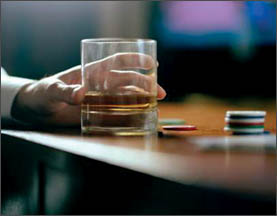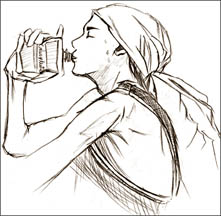Why men consume more alcohol than women
Dr. D. P. Atukorale
 Alcoholism: Alcohol has been consumed for millennia by man and
alcoholic beverages have been part of social life in all the countries
in the world. Compared with women throughout the world, men are more
likely to drink, consume more alcohol and cause more problem due to
drinking. Alcoholism: Alcohol has been consumed for millennia by man and
alcoholic beverages have been part of social life in all the countries
in the world. Compared with women throughout the world, men are more
likely to drink, consume more alcohol and cause more problem due to
drinking.
It is common knowledge that, in all the areas of the world, heavy
drinking, alcoholic intoxication and diseases due to drinking are more
common among males and abstinence is more common among females.
Reasons for gender differences in drinking behaviour are many. There
may be biological bases for these differences.
 It is believed women have lower rates of gastric metabolism of
alcohol than males. Females have smaller volume of body water in which
alcohol is distributed (York and Welte 1994). Women may be more likely
than men to experience the unpleasant acute effects of alcohol such as
hangover symptoms. It is believed women have lower rates of gastric metabolism of
alcohol than males. Females have smaller volume of body water in which
alcohol is distributed (York and Welte 1994). Women may be more likely
than men to experience the unpleasant acute effects of alcohol such as
hangover symptoms.
Research carried out in different countries has suggested for
categories of socio-cultural reasons why men's and women's drinking
patterns remain dissimilar: (i) power, (ii) Sex, (iii) Risks and (iv)
Responsibilities.
Power
The most common hypotheses to explain why men and women differ in
their drinking behaviour argue that alcohol consumption both symbolizes
and enhances men's greater power relative to women (McClelland and et
al, 1972)
Alcohol consumption, in large quantities has been an emblem of male
superiority over women (Marin, 2001). Ability to consumer large amounts
of alcohol without apparent impairment may help to demonstrate that the
drinker is manly (Neff et al 1991).
Drinking historically has been considered a male privilege
Alcohol seems to enhance power over others by facilitating aggressive
behaviour towards other people, more by men than by women (Bushman
1997). However the effect of alcohol depends on to some extent on
personal characteristics of male drinkers.
Men who want to bully or assault other people learn that alcohol
helps them to do this in certain circumstances. Greater aggressiveness
towards women could encourage more than discourage men's drinking. Heavy
drinking is known to help males in case of sexual assaults (Abbey 2002,
Testa 2002)
Sex
Both men and women may be motivated to drink by expectations that
alcohol will enhance their sexual performance and enjoyments (or will
make it easier for them to engage in sexual activity) (S. Wilsnackes et
al 1997) Drinking makes women more open to sexual advances by men.
Women have been socially influenced to drink less than men as a way
to restrain women's sexual behaviour and women are aware that their
drinking may increase their risks of vulnerability to male sexual
aggression (Abbey 2002)
Risks
Men drink more than women because men are generally more willing to
take risks than women (Byrnes et al 1999). This is because men find risk
- taking more inherently rewarding (exciting) than women do and risk
taking is an important part of demonstrating masculinity (but not
femininity) and it is known that women avoid risks more than men do
(Campbell et all 2001).
It has been shown that risk - taking effects by males is greatest in
later adolescence and early adulthood, before men get married and before
they become parents (Byrnes et al 1999).
Responsibilities
Men may be more likely to drink heavily because drinking either helps
them to ignore responsibilities (particularly domestic roles). On the
other hand, greater role responsibilities particularly at home may help
women to limit their drinking (Shore 1997) Culturally drinking in Sri
Lanka is mainly confined to males and drinking among females is
negligible. Heavy drinking among females is very rare in Sri Lanka.
Sri Lanka is at presently undergoing rapid changes in all the spheres
of life largely owing to the open economic policy introduced in 1977.
Frequent drinking is common only among males in all religious
communities in Sri Lanka and frequent drinking is rare among females. As
mentioned earlier, drinking among females is rare and drinking is more
common among females with high income as compared to low income groups.
In other words drinking is more common among so called educated upper
class women and low alcohol drinks like beer are popular among female
drinkers especially in urban areas of Sri Lanka while a few probably at
higher income levels take wine and whisky at parties.
Reference
Gender, Alcohol and Culture in Sri Lanka. Siri Hettige & Dharmadasa
Paranagama WHO, Dept. of Mental Health and Substance Abuse, Geneva. |

